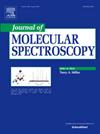Toward less ambiguous vibrational spectroscopic notations for hydrogen-bonded water and methanol clusters
IF 1.3
4区 物理与天体物理
Q4 PHYSICS, ATOMIC, MOLECULAR & CHEMICAL
引用次数: 0
Abstract
The hydrogen bond (HB), a non-covalent interaction, leads to diverse structural motifs that dictate the physical properties of materials or biochemical processes. Infrared spectroscopy allows straightforward access to such structural motifs from laboratory experiments. These spectra indirectly reveal HBs through vibrational frequency shifts in a molecular cluster compared to the single molecules. Characterizing these shifts with descriptive vibrational notations is challenging due to the delocalized nature of intermolecular vibrations. Typically, vibrations of clusters are represented in terms of the respective individual molecules. This approach is somewhat debatable, mainly when notations are based on experience or visual interpretation of theoretical models, most notably the normal mode framework. While normal modes are straightforward to obtain, they often provide insufficient descriptions of delocalized vibrations. Here, the decomposition of normal modes into contributions from internal coordinates allows for both an illustrative framework and a quantitative basis for vibrational notations. In the present work, we apply such a decomposition scheme to various HB systems, assessing the plausibility of notations used in IR spectroscopy of molecular clusters. For water, methanol, and clusters thereof, we demonstrate the limitations of conventional notations and how normal mode decomposition schemes can provide a reasonable workaround.

对氢键水和甲醇团簇较少模糊的振动光谱符号
氢键(HB),一种非共价相互作用,导致不同的结构基序,决定材料的物理性质或生化过程。红外光谱可以从实验室实验中直接获得这种结构基序。与单个分子相比,这些光谱通过分子簇中的振动频率位移间接揭示了HBs。由于分子间振动的离域性质,用描述性振动符号来描述这些变化是具有挑战性的。通常,簇的振动是用各自的单个分子来表示的。这种方法有些争议,主要是当符号是基于经验或理论模型的视觉解释时,最明显的是正常模式框架。虽然正常模态很容易获得,但它们往往不能充分描述离域振动。在这里,将正态模态分解为内部坐标的贡献,为振动符号提供了一个说明性框架和定量基础。在目前的工作中,我们将这种分解方案应用于各种HB系统,评估分子簇红外光谱中使用的符号的合理性。对于水、甲醇及其簇,我们展示了传统符号的局限性,以及正常模式分解方案如何提供合理的解决方案。
本文章由计算机程序翻译,如有差异,请以英文原文为准。
求助全文
约1分钟内获得全文
求助全文
来源期刊
CiteScore
2.70
自引率
21.40%
发文量
94
审稿时长
29 days
期刊介绍:
The Journal of Molecular Spectroscopy presents experimental and theoretical articles on all subjects relevant to molecular spectroscopy and its modern applications. An international medium for the publication of some of the most significant research in the field, the Journal of Molecular Spectroscopy is an invaluable resource for astrophysicists, chemists, physicists, engineers, and others involved in molecular spectroscopy research and practice.

 求助内容:
求助内容: 应助结果提醒方式:
应助结果提醒方式:


